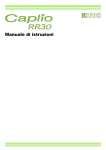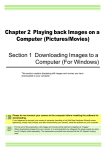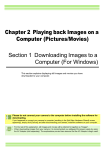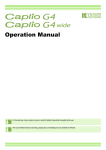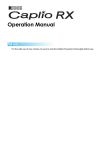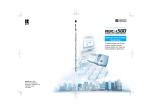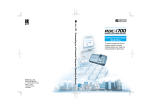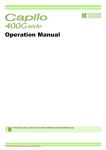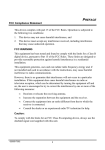Download Ricoh Caplio RICOH Gate for Windows User guide
Transcript
Software User Guide • For the safe use of your camera, be sure to read the “Safety Precautions” thoroughly before use. • Types of software installed on your computer varies depending on the method of installation from the Caplio Software CD-ROM. For details, see the “Camera User Guide”. Chapter 1 Downloading Images to Your Computer (Windows) This section explains how to download still images and movies to your computer (Windows). 4. Connecting the Camera to a Computer There are two methods for downloading images from the camera to your computer. The first method is to use RICOH Gate La. To use RICOH Gate La, Caplio Software must be installed. The second method is to download images without using RICOH Gate La. In this case, the camera is recognized by the computer as a separate drive and appears on [My Computer]. To use RICOH Gate La, select [ORIGINAL] for [USB CONNECTION] on the camera. To download images without using RICOH Gate La, select [MASS STR] for [USB CONNECTION] on the camera. For information on how to install Caplio Software and how to change the [USB CONNECTION] setting, see the “Camera User Guide”. 1. Your camera turns on. If [ORIGINAL] is selected for [USB CONNECTION] on the camera, RICOH Gate La starts. Proceed to “Downloading Images Using RICOH Gate La”. (GP.6) When [MASS STR] is selected for [USB CONNECTION], the computer automatically starts preparation for recognizing the camera as a new drive. Proceed to “Transferring Images in Mass Storage Mode”. (GP.9) Check the setting for [USB CONNECTION] on the camera’s SETUP menu. When downloading images from your camera, load a battery with adequate remaining power in the camera. Use of the AC adapter (sold separately) is recommended. For how to check the setting, see the “Camera User Guide”. At the time of purchase, [ORIGINAL] is selected. Make settings for [USB CONNECTION] according to the transfer method as follows: Software used for transfer [USB CONNECTION] setting The computer recognizes the camera as a drive without using software. MASS STR Auto Document Link ORIGINAL RICOH Gate La ORIGINAL 2. 3. Connect the USB cable to the USB terminal of your camera. Disconnecting the Camera from Your Computer The display is an example of Windows XP. The terms are different for other operating systems but the operations are the same. 1. Double-click the [Safely Remove Hardware] icon at the right end of the task bar. 2. Select [USB Mass Storage Device] and click [Stop]. 3. Check that [USB Mass Storage Device] is selected and click [OK]. 4. 5. Click [Close]. Turn the camera power off. Connect the USB cable to the USB port of your computer. 5 Unplug the USB cable. 4. Downloading Images to Your Computer Connect the USB cable to the USB terminal of your camera. When you connect the camera to your computer, you can download images from the camera. Downloading Images Using RICOH Gate La The camera turns on, RICOH Gate La starts, and the RICOH Gate La window appears. Images are downloaded to your computer from the following memory sources. When no SD memory card is loaded When an SD memory card is loaded Loads from internal memory Loads from the SD memory card Image transfer begins automatically. For details about RICOH Gate La, see P.10. • When transferring images to a computer using RICOH Gate La, the file being transferred is renamed and saved. RICOH Gate La automatically creates a folder called [Caplio] inside your [My Documents] folder. Downloaded images are saved in folders with the date of each shot, inside the [Caplio] folder. Set the correct date and time on the camera before shooting. 1. Set [USB CONNECTION] to [ORIGINAL] on the SETUP menu. 2. Make sure that the camera power is off. 3. • File names given by the camera are not used. • Images are stored with sequential numbers so that they have unique file names. • Even when the storage folder is changed, the file number will be continuous. The number cannot be initialized. • When transferring images to a computer using RICOH Gate La, the files are assigned names like [RIMG****.jpg] (**** indicates the number of the image), even if [SEQUENTIAL NO.] is set to [ON]. • If images are not automatically downloaded, check [Save automatically when connected to USB] in the RICOH Gate La [Option settings] dialog box. Connect the USB cable to the USB port of your computer. • For details about the RICOH Gate La [Option settings] dialog box, see P.11. • For details about [USB CONNECTION] (MASS STR/ ORIGINAL), see the “Camera User Guide”. 6 2. If the screen below appears, select [RICOH Gate La], check the box next to [Always use this program for this action] and then click [OK]. Insert the Caplio Software CDROM into the CD-ROM drive on your computer. Installation of the WIA driver automatically starts. If the CD-ROM is already on your computer when the [Found New Hardware Wizard] window is displayed, simply click [Next] to start installation. By default, the WIA driver is installed in the following location: If you have installed the ImageMixer: My Computer Local Disk • Before closing RICOH Gate La, if you turn the camera power off, or unplug the USB cable, the RICOH Gate La window is minimized and displayed as an icon on the Windows task bar. If you click the icon, the window will be displayed again. Program Files Caplio Software WIA driver • You can change the folder for downloading your images (Save Destination). If you have installed the DeskTopBinder Lite: My Computer • For how to change the Save Destination Folder, see P.11. Local Disk • For how to start RICOH Gate La, see P.10. Program Files • For the RICOH Gate La window, see P.10. Caplio Software S Connecting the Camera to the Computer for the First Time WIA driver The first time you connect your camera to the computer using a USB cable, the [Found New Hardware Wizard] screen will appear (only when [ORIGINAL] is selected for [USB CONNECTION]). The steps below use screenshots from Windows XP. 1. 3. Select [RICOH Gate La], check [Always use this program for this action] check box, and then click [OK]. • To load images from the camera with assistance from the Windows XP “Scanner and Camera Wizard”, select [Microsoft Scanner and Camera Wizard]. Select [Install the software automatically (Recommended)]. • Leaving the [Always use this program for this action] check box unchecked will cause the [Caplio XX] screen to be displayed each time you transfer images from the camera, thereby allowing you to choose whether to use [RICOH Gate La] or the [Microsoft Scanner and Camera Wizard] for image transfers. 7 If you clicked the [Keep Blocking] button: Follow the steps below to check to see the Windows Firewall settings. 1. Click [Start] and then [Control Panel]. 2. Double-click [Windows Firewall]. Warning Messages Under Windows XP Service Pack 2 When software for Ricoh’s digital camera is used on a computer with Windows XP Service Pack 2 installed, the following warning message may appear at software activation or USB connection. Change the setting while referring to the following. If [Windows Firewall] is not displayed, click [Switch to Classic View] at the upper left of the window. When warning messages appear: 1. 3. Click the [Exceptions] tab. 4. Check that the software is in [Programs and Services]. 5. Click the [Add Program] button to add software that uses the network. Check the information provided on the message screen to make sure that it comes from a reputable source, and then click the [Unblock] button. Caution If you do not recognize the program, you should block it because it may be a virus. Click the [Keep Blocking] button to prevent the program from connecting to the Internet. If you clicked the [Ask Me Later] button: Each time the program is activated, the [Windows Security Alert] window appears. Then you can select [Unblock]. 8 Transferring Images in Mass Storage Mode Caution Do not turn off the camera or disconnect the USB cable during image transfer. Caution Mass storage mode is not available on this camera if you are using Windows 98/98SE. 1. Set [USB CONNECTION] to [MASS STR] on the SETUP menu. • If a file with the same name already exists at the destination, it is overwritten. If you do not want the file to be overwritten, rename the file or transfer data to another folder. 2. Make sure that the camera power is off. 3. • When an SD memory card is loaded, its files are displayed. Otherwise, files in the internal memory are displayed. Connect the accessory USB cable to a USB port of your computer. 4. Connect the USB cable to the USB terminal of your camera. Your camera turns on. Your computer automatically reads the file necessary for recognizing the camera as a drive. After this preparation, the camera is displayed as a drive at [My Computer]. Example of the display in Windows XP 5. From the displayed drive, copy a file to the desired location. The figure below shows the folder configuration of the drive. When the contents of the internal memory are displayed, the drive name is [RICOHDCI]. 9 How to Use RICOH Gate La 1 [MENU] Button Click this and the following menu appears. RICOH Gate La is a software program to import images from the camera to a computer. By simply connecting the camera to your computer via a USB cable, images are automatically imported to the computer. On the RICOH Gate La window, you can make various settings including auto-saving upon connection and the destination folder (where images will be saved). [Option settings] Specifies where to save images, or which application to start after images have been saved or when you click the [Application] button. (GP.11) [Background illustration settings] Changes the background design in the RICOH Gate La window. (GP.12) [About] Displays the version of RICOH Gate La. [Exit] Closes RICOH Gate La. Starting RICOH Gate La is already installed with Caplio Software. Connecting the camera to your computer automatically starts the software and begins downloading of images from the camera. Exiting To exit RICOH Gate La, follow either of the steps below. • Click the [MENU] button on the RICOH Gate La window and select [Exit] from the displayed menu (see “The RICOH Gate La Window”). 2 [Save] Button Click this and the images are downloaded from your camera. • Right-click the RICOH Gate La icon on the task bar and select [Exit] from the displayed menu. Caution If the message indicating that [CONNECTING... PRESS [ADJ.] KEY TO DIRECT PRINT] appears on the camera LCD monitor, do not click the [Save] button. Restarting To restart RICOH Gate La after exiting, follow the steps below. • From the [Start] menu, select [All Programs] or [Programs] then [Caplio Software] then [RICOH Gate La]. 3 [Application] Button The application registered in [Option settings] is started. 4 [Minimize] Button Minimizes the window and displays its icon on the Windows task bar. If you click on the icon, the window will be displayed again. The RICOH Gate La Window Once RICOH Gate La starts up, the following RICOH Gate La window appears on your computer screen. 5 Indicator The “Indicator” lights if the camera is connected via USB cable. When lit, if you move the mouse pointer over the “Indicator”, [Camera is being connected] appears. When your camera is not connected, the “Indicator” is grayed out, and if you move the mouse pointer over it, [Camera is being connected] does not appear. 10 How to Use the [Option settings] If you click the [MENU] button on the RICOH Gate La window and select [Option settings] from the displayed menu, the [Option settings] dialog box appears. Item Description Initial Setting 1 [Save automatically when connected to USB] Select the check box to have images downloaded and saved automatically in your Save computer when the camera is connected to your computer with the USB cable. automatically If you deselect the check box, your images will not be downloaded automatically when you connect your camera to the computer. For downloading, activate RICOH Gate La and click the [Save] button. 2 [Destination folder] Specifies which folder to save your images in. The [Caplio] folder inside [My Documents] is specified initially; if you want to change this, click the [Browse] button to display the dialog box and then specify the folder. 3 [Create folder] Specifies how to create a folder. [Not created] Your downloaded images will all be saved in the folder specified in item “2 [Destination folder]”. [For each date photographed] Creates a new folder assigning the date the images were shot as the folder name, and saves images shot on the same day in the same folder. For example, if shot on September 1, 2006: [20060901] folder [For each time saved] Creates a new folder each time and save images in the folder. If images are saved more than once in a day, a new folder is created each time. The folder name format is “Saving date + Underscore + Three-digit serial number”. For example, if you saved twice on September 1, 2006: [20060901_001] folder, [20060901_002] folder 4 [The same image will not be saved] When this check box is selected, images once loaded into your computer are The same image not loaded again. This check box is enabled only when [Not created] or [For will not be saved each date photographed] is selected in [Create folder]. To allow this function to work properly, the camera date and time must be set correctly. When this check box is deselected, previously loaded images are loaded again. 5 [Application software settings] To start an application after loaded images have been saved, specify the application name here. To set an application, click the [Browse] button and select the application in the displayed dialog box. 6 [Save and start application software] When this is checked, the application specified above is started after the images have been saved. When this is unchecked, the application is not started. Application is started 7 [Camera’s IP Address] Not used by this model but used by other models of Caplio camera. For details, see the documentation that came with the camera. 0.0.0.0 11 Create a new folder for each date photographed Downloading Images from an SD Memory Card How to Use the [Background illustration settings] You can select a background for the RICOH Gate La window from three types of patterns. If you click the [MENU] button on the RICOH Gate La window and select [Background illustration settings] from the displayed menu, the [Background illustration settings] dialog box appears. It is possible to download images from an SD memory card to computer via a PC card slot or card reader. Images in an SD Memory Card Images are stored on an SD memory card in a hierarchy, as shown here. 1 [Background illustration pattern] Select the pattern you wish to use from the three available. Image files Depending on the type of PC card slot or card reader, a memory card adapter may be required when using an SD memory card. If the SD memory card can be used in the PC card slot, no memory card adapter is required. Card Reader This is a device connected to a computer to read the contents of cards. In addition to the memory card adapter-type, there are card readers into which you can directly load an SD memory card. 2 [Preview] You can preview the pattern selected in [Background illustration pattern]. 12 Chapter 2 Downloading Images to Your Computer (Macintosh) This section explains how to download still images and movies to your computer (Macintosh). 4. Connecting the Camera to a Computer The following methods can be used to download images from the camera to your computer. The first method is to use RICOH Gate La or Caplio Mounter. To use these software titles, Caplio Software must be installed. The second method is to download images without using software. In this case, the camera is recognized by the computer as a separate drive and appears on [My Computer]. To use software to download images, select [ORIGINAL] for [USB CONNECTION] on the camera. To download images without using software, select [MASS STR] for [USB CONNECTION] on the camera. For information on how to install Caplio Software and how to change the [USB CONNECTION] setting, see the “Camera User Guide”. 1. Connect the USB cable to the USB terminal of your camera. Your camera turns on. If [ORIGINAL] is selected for [USB CONNECTION] on the camera, the software starts. Proceed to “Using the Caplio Software to Download Images”. (GP.15) When [MASS STR] is selected for [USB CONNECTION], the computer automatically starts preparation for recognizing the camera as a new drive. Proceed to “Transferring Images in Mass Storage Mode”. (GP.17) Check the setting for [USB CONNECTION] on the camera’s SETUP menu. For how to check the setting, see the “Camera User Guide”. At the time of purchase, [ORIGINAL] is selected. Make settings for [USB CONNECTION] according to the transfer method as follows: When downloading images from your camera, load a battery with adequate remaining power in the camera. Use of the AC adapter (sold separately) is recommended. Software used for transfer [USB CONNECTION] setting Disconnecting the Camera from Your Computer The computer recognizes the camera as a drive without using software. MASS STR 1. RICOH Gate La ORIGINAL Caplio Mounter ORIGINAL 2. 3. Drag and drop the displayed drive to the [Trash] icon. You can also click [Eject] on the [Special] menu in Mac OS 9 or the [File] menu in Mac OS X to cancel the connection. 2. Turn the camera power off. Connect the USB cable to the USB port of your computer. 14 Unplug the USB cable. Downloading Images to Your Computer When you connect the camera to your computer, you can download images from the camera. Using the Caplio Software to Download Images 1. Set [USB CONNECTION] to [ORIGINAL] on the SETUP menu. 2. Make sure that the camera power is off. 3. Connect your camera to the computer using the USB cable. The camera turns on, RICOH Gate La starts, and the RICOH Gate La window appears. Images are downloaded to your computer from the following memory sources. When no SD memory card is loaded When an SD memory card is loaded Loads from internal memory Loads from the SD memory card Image transfer begins automatically. For details about RICOH Gate La, see P.18. • When transferring images to a computer using RICOH Gate La, the file being transferred is renamed and saved. • File names given by the camera are not used. • Images are stored with sequential numbers so that they have unique file names. Downloading methods differ depending on the environment used. Refer to the respective page to download your images. OS Software used Refer to Mac OS 8.6 to 9.2.2 RICOH Gate La, Caplio Mounter P.15 P.16 Mac OS X 10.1.2 to 10.4.6 Caplio Mounter P.16 • Even when the storage folder is changed, the file number will be continuous. The number cannot be initialized. • When transferring images to a computer using RICOH Gate La, the files are assigned names like [RIMG****.jpg] (**** indicates the number of the image), even if [SEQUENTIAL NO.] is set to [ON]. • If images are not automatically downloaded, check [Automatically save on connection] in the RICOH Gate La [Option settings] dialog box. • Before closing RICOH Gate La, if you turn the camera power off or unplug the USB cable, RICOH Gate La closes automatically. Downloading Images Using RICOH Gate La • You can change the folder for downloading your images (Save Destination). For Mac OS 8.6 to 9.2.2 • If you want to start RICOH Gate La when the camera is not connected, double-click the [RICOH Gate La] icon in the Control Panel folder, which is inside the System Folder. Images downloaded by RICOH Gate La are saved in folders with the date of each shot, inside the [Caplio] folder. Set the correct date and time on the camera before shooting. In Mac OS 8.6, Mac OS 9.1, or earlier versions, a folder called [Caplio] is created inside the root directory on the startup disc. In Mac OS 9.1 to 9.2.2, a folder called [Caplio] is automatically created inside the [Documents] folder on the startup disc. 15 When an SD memory card is loaded, the [Caplio.SD] icon is displayed and you can view the image files stored on the SD memory card loaded. • For details about the RICOH Gate La [Option settings] dialog box, see P.19. • For details about [USB CONNECTION] (MASS STR/ ORIGINAL), see the “Camera User Guide”. • For how to change the Save Destination Folder, see P.19. • For how to start RICOH Gate La, see P.18. • For the RICOH Gate La window, see P.18. Example of the display in Mac OS 10.1.2 to 10.4.6 4. Downloading Images Using the Caplio Mounter It can be handled in the same way as a normal drive. If you double-click the icon, a folder called [DCIM] is displayed and a folder called [100RICOH] within that folder is displayed. The image files you shot are inside the [100RICOH] folder. You can use drag and drop to copy files to the hard disk. For Mac OS 8.6 to 9.2.2 For Mac OS X 10.1.2 to 10.4.6 When downloading images to a computer using the Caplio Mounter, you can specify a folder where the images will be saved. 1. Set [USB CONNECTION] to [ORIGINAL] on the SETUP menu. 2. Make sure that the camera power is off. 3. Connect your camera to the computer using the USB cable. Double-click the displayed icon. Caution When using the Caplio Mounter, you cannot write data onto an SD memory card. Your camera turns on. When no SD memory card is loaded, the [Caplio] icon is displayed and you can view the image files stored in internal memory. Example of the display in Mac OS 10.1.2 to 10.4.6 16 Transferring Images in Mass Storage Mode Caution Do not turn off the camera or disconnect the USB cable during image transfer. Caution Mass storage mode is not available on this camera if you are using Mac OS 8.6. 1. • If a file with the same name already exists at the destination, it is overwritten. If you do not want the file to be overwritten, rename the file or transfer data to another folder. Set [USB CONNECTION] to [MASS STR] on the SETUP menu. 2. Make sure that the camera power is off. 3. Connect the accessory USB cable to a USB port of your computer. 4. Connect the USB cable to the USB terminal of your camera. • When an SD memory card is loaded, its files are displayed. Otherwise, files in the internal memory are displayed. Your camera turns on. Your computer automatically reads the file necessary for recognizing the camera as a drive. After this preparation, the camera is displayed as a drive on the Desktop. 5. From the displayed drive, copy a file to the desired location. The figure below shows the folder configuration in the drive. When the contents of the internal memory are displayed, the drive name is [RICOHDCI]. 17 How to Use RICOH Gate La 1 [About RICOH Gate La] Displays the version of RICOH Gate La. RICOH Gate La is a software program to import images from the camera to a computer. By simply connecting the camera to your computer via a USB cable, images are automatically imported to the computer. On the RICOH Gate La window, you can make various settings including auto-saving upon connection and the destination folder (where images will be saved). 2 [Quit] Closes RICOH Gate La. 3 [Option settings] Specifies where to save images, or which application to start after images have been saved or when you click the [Application] button. (GP.19) [Background illustration] If you select this, a sub-menu will appear, allowing you to change the background design of the RICOH Gate La window. Starting Connecting the camera to your computer automatically starts RICOH Gate La and begins importing of images from the camera. Quitting To quit RICOH Gate La, select [File] and then [Quit] from the RICOH Gate La menu bar. Sub-menu Figure Restarting 4 [Save] Button Click this and the images are downloaded from your camera. To restart RICOH Gate La after quitting, double-click the [RICOH Gate La] icon in the Control Panel folder in the System Folder. 5 [Application] Button The application registered in [Option settings] is started. The RICOH Gate La Window 6 Indicator The “Indicator” lights if the camera is connected via USB cable. Once RICOH Gate La starts up, the following RICOH Gate La menu bar and window appear on the computer screen. 18 How to Use the [Option settings] If you select [Option settings] from the [RICOH Gate La Setup] menu, the [Option settings] dialog box appears. Item Description Initial Setting 1 [Automatically save on connection] Select the check box to have images downloaded and saved automatically Transfer files in your computer when the camera is connected to your computer with the automatically USB cable. If you deselect the check box, your images will not be downloaded automatically when you connect your camera to the computer. For downloading, activate RICOH Gate La and click the [Save] button. 2 [Choose] Specifies which folder to save your images in. For Mac OS 8.6, Mac OS 9.1, or earlier versions, this is the [Caplio] folder in the root directory on the startup disk. For Mac OS 9.1 to 9.2.2, this is the [Caplio] folder inside the [Documents] folder on the startup disk. To change the folder, click the [Choose] button, open the dialog box, and then select the desired folder. 3 [Automatically create folder on saving] When this check box is selected, a folder to save the loaded images is automatically created. Use the adjacent pull-down menu in [Destination settings] to specify how to create the folder. [For each date photographed] Creates a new folder assigning the date the images were shot as the folder name, and saves images shot on the same day in the same folder. For example, if shot on September 1, 2006: [20060901] folder [For each time saved] Creates a new folder for each time images are saved and saves the images. If images are saved more than once in a day, a new folder is created each time. The folder name format is “Saving date + Underscore + Three-digit serial number”. For example, if saved twice on September 1, 2006: [20060901_001] folder, [20060901_002] folder When this check box is deselected, loaded images are all saved to the folder specified in “2 [Choose]”. 4 [The same image will not be saved.] When this check box is selected, images once loaded into your computer are The same image not loaded again. This can only be specified when [Automatically create will not be saved folder on saving] is deselected or when “3 [For each date photographed]” is selected as the method for creating the folder. To allow this function to work properly, the camera date and time must be set correctly. When this check box is deselected, previously loaded images are loaded again. 5 [Save and start application software] When this is checked, the application specified above is started after the images have been saved. When this is unchecked, the application is not started. 6 [Choose] Specify the name of the application to start after images have been saved. Click the [Choose] button to display the dialog box, and then specify which application to use. 19 Create a new folder for each date photographed Application is not started Downloading Images from an SD Memory Card It is possible to download images from an SD memory card to computer via a PC card slot or card reader. Images in an SD Memory Card Images are stored on an SD memory card in a hierarchy, as shown here. Image files Depending on the type of PC card slot or card reader, a memory card adapter may be required when using an SD memory card. If the SD memory card can be used in the PC card slot, no memory card adapter is required. 20 Appendices Troubleshooting Problem 1 Cannot download images Solution 1 The [USB CONNECTION] setting on the camera’s SETUP menu may not match the transfer method preferred. Make settings for [USB CONNECTION] according to the software used for transfer as follows: Software used for transfer [USB CONNECTION] setting The computer recognizes the camera as a drive without using software. MASS STR Auto Document Link ORIGINAL RICOH Gate La ORIGINAL Solution 2 Your computer does not recognize the camera correctly. Follow the steps below. zFor Windows 98/98SE/Me Procedure 1: First, follow the steps below. 1. Load the Caplio Software CD-ROM into your computer. 2. Connect your camera via the USB cable to your computer. 3. Click the [Start] button on the Windows taskbar to display the [Start] menu. 4. Select [Settings], and then click [Control Panel]. 5. On the Control Panel displayed, double-click the [System] icon. 6. On the [System Properties] screen displayed, click the [Device Manager] tab. 7. On the [Device Manager] tab page displayed, click [+] on the left side of [Other devices]. 8. Check if there is [Caplio XX] below it. If there is, click [Caplio XX], and then click the [Remove] button at the bottom of the [Device Manager] tab. The entry [Caplio XX] is deleted. 9. Click [Close] to close the [System Properties] screen. 10. When the display returns to the Control Panel, double-click the [Add/Remove Programs] icon. 11. On the [Add/Remove Programs Properties] screen displayed, select [Caplio Software], and then click the [Add/Remove] button. This uninstalls the Caplio Software. 12. Click [OK] to close the [Add/Remove Programs Properties] screen. 13. Click the [×] (Close) button to close the Control Panel. 14. Turn off your camera and computer. 15. Turn your computer back on and reinstall the software from the CD-ROM. *At this time, do not connect your camera. 16. Connect your camera via the USB cable to your computer. When the computer recognizes the camera, the [New Hardware Found] screen launches and your camera is registered by the computer. 22 Procedure 2: If your computer still does not recognize the camera, follow the steps below. 1. Load the Caplio Software CD-ROM into your computer. 2. Connect your camera via the USB cable to your computer. 3. Click the [Start] button on the Windows taskbar to display the [Start] menu. 4. Select [Settings], and then click [Control Panel]. 5. On the Control Panel displayed, double-click the [System] icon. 6. On the [System Properties] screen displayed, click the [Device Manager] tab. 7. On the [Device Manager] tab page displayed, click [+] on the left side of [Ports (COM & LPT)] to open. 8. Check whether or not there is an unknown device symbol (!) indicated for [RICOH Camera Port] below [Ports (COM & LPT)]. If there is, select it, and then click the [Remove] button at the bottom of the [Device Manager] tab to delete it. 9. Click [+] on the left side of [Universal Serial Bus controllers] to open. 10. Check whether or not there is an unknown device symbol (!) indicated for [RICOH USB Virtual Com] below [Universal Serial Bus controllers]. If there is, select it, and then click the [Remove] button at the bottom of the [Device Manager] tab to delete it. 11. Click [Close] to close the [System Properties] screen. 12. When the display returns to the Control Panel, double-click the [Add/Remove Programs] icon. 13. On the [Add/Remove Programs Properties] screen displayed, select [Caplio Software], and then click the [Add/Remove] button. This uninstalls the Caplio Software. 14. Click [OK] to close the [Add/Remove Programs Properties] screen. 15. Click the [×] (Close) button to close the Control Panel. 16. Turn off your camera and computer. 17. Turn your computer back on and reinstall the software from the CD-ROM. *At this time, do not connect your camera. 18. Connect your camera via the USB cable to your computer. When the computer recognizes the camera, the [New Hardware Found] screen launches and your camera is registered by the computer. 23 zFor Windows 2000 Procedure 1: First, follow the steps below. 1. Load the Caplio Software CD-ROM into your computer. 2. Connect your camera via the USB cable to your computer. 3. Click the [Start] button on the Windows taskbar to display the [Start] menu. 4. Select [Settings], and then click [Control Panel]. 5. On the Control Panel displayed, double-click the [System] icon. 6. On the [System Properties] screen displayed, click the [Hardware] tab. 7. On the [Hardware] tab page displayed, click the [Device Manager] button. 8. On the [Device Manager] screen displayed, click [+] on the left side of [Other devices]. 9. Check if there is [Caplio XX] below it. If there is, click [Caplio XX], and then click the [Uninstall] from the [Action] menu. The entry [Caplio XX] is deleted. 10. Click the [×] (Close) button to close the [Device Manager] screen. 11. Click [OK] to close the [System Properties] screen. 12. When the display returns to the Control Panel, double-click the [Add/Remove Programs] icon. 13. On the [Add/Remove Programs] screen displayed, select [Caplio Software], and then click the [Change/Remove] button. This uninstalls the Caplio Software. 14. Click the [×] (Close) button to close the [Add/Remove Programs] screen. 15. Click the [×] (Close) button to close the Control Panel. 16. Turn off your camera and computer. 17. Turn your computer back on and reinstall the software from the CD-ROM. *At this time, do not connect your camera. 18. Connect your camera via the USB cable to your computer. When the computer recognizes the camera, the [Found New Hardware] screen launches and your camera is registered by the computer. 24 Procedure 2: If your computer still does not recognize the camera, follow the steps below. 1. Load the Caplio Software CD-ROM into your computer. 2. Connect your camera via the USB cable to your computer. 3. Click the [Start] button on the Windows taskbar to display the [Start] menu. 4. Select [Settings], and then click [Control Panel]. 5. On the Control Panel displayed, double-click the [System] icon. 6. On the [System Properties] screen displayed, click the [Hardware] tab. 7. On the [Hardware] tab page displayed, click the [Device Manager] button. 8. On the [Device Manager] screen displayed, click [+] on the left side of [Ports (COM & LPT)] to open. 9. Check whether or not there is an unknown device symbol (!) indicated for [RICOH Camera Port] below [Ports (COM & LPT)]. If there is, click it, and then click the [Uninstall] from the [Action] menu. 10. Click the [×] (Close) button to close the [Device Manager] screen. 11. Click [OK] to close the [System Properties] screen. 12. When the display returns to the Control Panel, double-click the [Add/Remove Programs] icon. 13. On the [Add/Remove Programs] screen displayed, select [Caplio Software], and then click the [Change/Remove] button. This uninstalls the Caplio Software. 14. Click the [×] (Close) button to close the [Add/Remove Programs] screen. 15. Click the [×] (Close) button to close the Control Panel. 16. Turn off your camera and computer. 17. Turn your computer back on and reinstall the software from the CD-ROM. *At this time, do not connect your camera. 18. Connect your camera via the USB cable to your computer. When the computer recognizes the camera, the [Found New Hardware] screen launches and your camera is registered by the computer. 25 zFor Windows XP Procedure 1: First, follow the steps below. 1. Load the Caplio Software CD-ROM into your computer. 2. Connect your camera via the USB cable to your computer. 3. Click the [Start] button on the Windows taskbar to display the [Start] menu. 4. Click [Control Panel]. 5. On the Control Panel displayed, click [Switch to Classic View]. The display changes its appearance and the [System] icon appears. 6. Double-click the [System] icon. 7. On the [System Properties] screen displayed, click the [Hardware] tab. 8. On the [Hardware] tab page displayed, click the [Device Manager] button. 9. On the [Device Manager] screen displayed, click [+] on the left side of [Other devices]. 10. Check if there is [Caplio XX] below it. If there is, right-click [Caplio XX] to display the menu and select [Update Driver]. 11. Windows will display the [Hardware Update Wizard] screen. At this point, check that the Caplio Software CD-ROM is inserted in your computer. If the CD-ROM is not inserted, insert in your computer. 12. Make sure that [Install the software automatically (Recommended)] is selected, and then click [Next]. 13. When the [Completing the Hardware Update Wizard] screen appears, click [Finish]. 14. Click the [×] (Close) button to close the [Device Manager] screen. 15. Click [OK] to close the [System Properties] screen. 16. Click the [×] (Close) button to close the Control Panel. 17. Turn off your camera and computer. 18. Turn your computer back on and reinstall the software from the CD-ROM. *At this time, do not connect your camera. 19. Connect your camera via the USB cable to your computer. When the computer recognizes the camera, the [New Hardware Found] screen launches and your camera is registered by the computer. 26 Procedure 2: If your computer still does not recognize the camera, follow the steps below. 1. Load the Caplio Software CD-ROM into your computer. 2. Connect your camera via the USB cable to your computer. 3. Click the [Start] button on the Windows taskbar to display the [Start] menu. 4. Click [Control Panel]. 5. On the Control Panel displayed, click [Switch to Classic View]. The display changes its appearance and the [System] icon appears. 6. Double-click the [System] icon. 7. On the [System Properties] screen displayed, click the [Hardware] tab. 8. On the [Hardware] tab page displayed, click the [Device Manager] button. 9. On the [Device Manager] screen displayed, click [+] on the left side of [Imaging devices] to open. 10. Check whether or not there is an unknown device symbol (!) indicated for [Caplio XX]. If there is, right-click the unknown device symbol to display the menu and select [Update Driver]. 11. Windows will display the [Hardware Update Wizard] screen. At this point, check that the Caplio Software CD-ROM is inserted in your computer. If the CD-ROM is not inserted, insert in your computer. 12. Make sure that [Install the software automatically (Recommended)] is selected, and then click [Next]. 13. When the [Completing the Hardware Update Wizard] screen appears, click [Finish]. 14. Click the [×] (Close) button to close the [Device Manager] screen. 15. Click [OK] to close the [System Properties] screen. 16. Click the [×] (Close) button to close the Control Panel. The driver is installed and your computer recognizes the camera correctly. 27 Solution 3 For Windows 98/98SE/Me, the COM Port setting may be wrong. Follow the steps below. 1. Connect your camera via the USB cable to your computer. 2. Click the [Start] button on the Windows taskbar to display the [Start] menu. 3. Select [Settings], and then click [Control Panel]. 4. On the Control Panel displayed, double-click the [System] icon. 5. On the [System Properties] screen displayed, click the [Device Manager] tab. 6. On the [Device Manager] tab page displayed, click [+] on the left side of [Ports (COM & LPT)] to open. 7. Click [RICOH Camera Port] under [Ports (COM & LPT)], and then click the [Properties] button at the bottom of the [Device Manager] tab. 8. On the [RICOH Camera Port Properties] screen displayed, Click the [PortSelect] tab. 9. On the [PortSelect] tab page displayed, select a COM Number not being used from [PortName]. The port (COM number) currently allocated for your camera is indicated by a “*”. Immediately after installing the USB driver, COM7 should be selected, so select a number above COM8. 10. Click [OK] to close the [RICOH Camera Port Properties] screen. 11. Click [OK] to close the [System Properties] screen. 12. Click the [×] (Close) button to close the Control Panel. Solution 4 Your camera may not be recognized correctly if you connect to the USB Port of your computer via a USB hub. Follow the steps below to change the USB port. • Connect your camera directly to the USB port of your computer. • If there are several root hubs, change to another hub. If you are using a non-USB hub, try connecting via a USB hub. Solution 5 The batteries may have worn out. Check whether the batteries have worn out. If worn out, replace them with new ones. Solution 6 The free space on the hard disk in your computer may be insufficient. Check whether the hard disk has sufficient space for running Windows, and whether the drive where you are loading image files has the same capacity or more as that of the SD memory card inserted in the camera. 28 Problem 2 Even if you check [The same image will not be saved] in the RICOH Gate La [Option settings], the same images are loaded into your computer. Solution The camera’s clock is incorrectly set or the camera’s clock information has been reset. To allow the [The same image will not be saved] function to work properly, the camera’s clock information must be set properly. Set it properly. Problem 3 Files loaded from the camera into the computer were deleted. You attempted to load the same files from the camera again but failed. Solution If [The same image will not be saved] is checked in the RICOH Gate La [Option settings], files loaded into your computer once cannot be loaded again. In the RICOH Gate La [Option settings], uncheck [The same image will not be saved]. Problem 4 Cannot play back movies with ImageMixer Solution DirectX may not be installed. (Windows 98/98SE/Me/2000) Install DirectX from the Caplio Software CD-ROM. Problem 5 RICOH Gate La is always activated when the camera is connected to a Windows XP computer through a USB cable. Solution Connect the camera to the computer through the USB cable, and then open [My Computer] from the [Start] menu on Windows Taskbar. Right-click the camera icon on the My Computer screen and click [Properties] to open the camera’s Properties screen. Click the [Events] tab on the Properties screen. Select [Take no action] or [Prompt for which program to run] for [Actions] and click [OK]. If [Take no action] is selected, nothing happens when the camera is connected to the computer. If [Prompt for which program to run] is selected, a screen is displayed each time the camera is connected to the computer. Then you can choose a program to activate. Problem 6 [Failed to save.] appears during image loading from the camera into your computer Solution Set the camera to Playback Mode and check that [UNMATCHED FILE] is not displayed for any file. If [UNMATCHED FILE] is displayed, delete the file from the SD memory card or internal memory after backing up all files on your computer. For backup, copy all files into your computer directly by using a commercially-available card reader or by changing the [USB CONNECTION] setting to [MASS STR] on the SETUP menu. After copying, return the [USB CONNECTION] setting to [ORIGINAL]. 29 Problem 7 RICOH Gate La does not appear in the [Device connected] screen when the camera is connected to a Windows XP computer through a USB cable. Solution Set the camera to Playback Mode and check if the message [FORMAT CARD] is displayed. If the message is displayed, check that the SD memory card does not contain any image you do not want to delete, and then select [FORMAT [CARD]] (see the “Camera User Guide”) on the SETUP menu to format the SD memory card. Problem 8 The Caplio Software CD-ROM is not available when you attempt to connect your camera via the USB cable to the computer (Windows XP) for the first time, therefore you cannot install the hardware driver for the camera. Solution 1. Connect your camera to the computer. The [Found New Hardware Wizard] window appears. 2. Select [Install from a list or specific location (Advanced)]. 3. Click [Next]. 4. Select [Search for the best driver in these locations.] and [Include this location in the search], and then click the [Browse] button. 5. Browse to the folder where the [WIA driver] was installed (by default this should be C:\Program Files\Caplio Software\WIA driver) and then select [Next]. 6. Select [RICOH Gate La], select the [Always use this program for this action] check box, and then click [OK]. 30





























